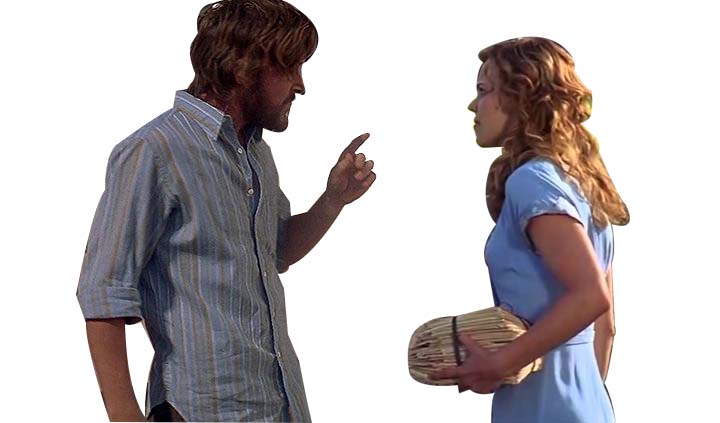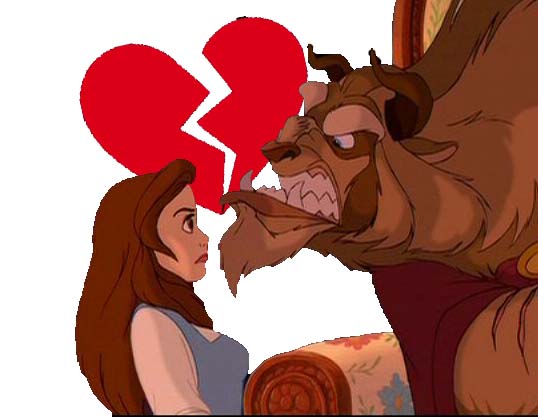Bad fictional couples. Ross and Rachel, Chuck and Blair, Danny and Sandy, Cathy and Heathcliff. Pretty much everybody can name a few they have a soft spot for but know deep down shouldn’t be together.
But why in this age of promoting healthy #relationshipgoals on Instagram we still fall for characters, both fictional and in real life, who are just straight up bad?
Kathleen McConnell, professor of English literature at St. Thomas University, says one example of a troublesome love affair we love to love is Beauty and the Beast.
“The clear message there is: if you marry a beast he will turn into a handsome prince. And you wonder, how many girls fell for that and regretted it later?”
Belle’s Stockholm syndrome aside, one of the troubling tropes we see in Beauty and the Beast and many other love stories is the idea one person in a relationship can “fix” or change the other. Blinded by love, they suffer abuse, whether emotional, mental or physical, in hope the other person will change if they can love them enough. And it’s no coincidence the one trying to change the other is often the female in the relationship.
“As a culture we take great pleasure in watching women suffer,” McConnell says.
“There’s something that we like about witnessing and maybe empathizing with, somebody suffering. And then seeing them come out to a happily ever after at the end. Whether or not that happily ever after is realistic doesn’t seem to matter.”
The difficulty is, those unrealistic and unhealthy ideas about what love is are fed to us from a very young age. McConnell says because suffering is so engaging to watch, especially when it is rewarded with a happy ending, we start to idealize and romanticize unhealthy relationship behaviors that lead to those dramatic, making-out-in-the-rain silver screen moments. If you’re a bird, I’m a bird, so I am going to not communicate my needs and desires and manipulate and abuse you instead. That’s love, right?
McConnell pointed out the most tempestuous and fiery love stories are usually marketed to a youthful audience – think Riverdale, Gossip Girl, Twilight or anything by Nicholas Sparks.
“And then we try to play it out in our real life and discover it’s not a good idea.”
Yeah. Manipulating your controlling vampire boyfriend by threatening to kill yourself so he comes back to you doesn’t seem like a great idea to me.

Whether it’s being raised on Disney’s plethora of unhealthy romantic relationships as children or sold on Gatsby’s creepy devotion to Daisy in our high school literature classes, our culture teaches us to enjoy stories of suffering and become complicit in the questionable behavior of our beloved characters.
“What’s the difference between great love and stalking?” McConnell asked.
Turns out a lot of it has to do with perspective.
McConnell says historically the perspective has predominantly been a man putting a woman on a pedestal and making her out to be more than human, simultaneously idolizing and objectifying her. This idea traces back at least as far as the ancient Greek myth of Pygmalion, a sculptor, and Galatea, his stone creation he falls in love with.
“The problem when you have a lover who is treating the beloved as something more than human, they’re bound to be disappointed when the relationship actually really continues,” McConnell says.
According to McConnell, we become complicit with unhealthy behaviors like obsession and objectification because of the way writers and media creators “lead us down the garden path,” with storytelling that gets us empathizing and investing in the characters. And so Gatsby’s green light and extravagant parties become romantic gestures rather than signs of unhealthy obsession.
Unhealthy romantic behaviors are still glorified in the media today. Silver Linings Playbook may be a film that brings discussions of mental illness into the rom-com scene, but it still makes viewers support the mismatched paring of Tiffany and Pat, even though neither character is stable enough to be in a healthy relationship. As Peter Travers writes in his Rolling Stone review, “Only in Hollywood can mental illness be cured by moonstruck fantasy.”

Compared to grandiose romantic gestures and passionate stormy affairs, healthy relationships tend to draw the short end of the stick, usually appearing in ironic comedies about middle-aged couples. Modern Family is a hilarious sitcom, but romance between characters is generally made slightly ridiculous, like Phil and Claire’s Valentine’s Day alter-egos Clive and Juliana, who, despite trying to be super sexy for V-Day, end up into scrapes much more realistic, embarrassing and relatable.
Think about a fire. If you don’t pay any attention to it the coals will grow cold and burn out. But if you pour on too much fuel the wood will burn up too quickly, glowing bright and hot for an instant before destroying everything. A good fire is one that throws heat, but isn’t out of control. It’s comfortable, but still requires constant work to maintain it. It’s not as exciting as a raging bonfire the size of a house, but at the end of the day, there’s no other place you’d rather set your feet up in front of to feel revitalized. A good relationship is like a moderate fire – it keeps you warm without burning your eyebrows off.
While more questions are being asked about the values displayed in our media, culture is complicated, so we shouldn’t expect all representations of unhealthy couples to disappear overnight. Nor should we want them to, since there’s so much we can learn from these representations.
McConnell say awareness is key, as well as a conscious effort not to reproduce fiction in our actions and writing.
“It’s like going to the grocery store. Read the box, you want to know what’s in there.”

